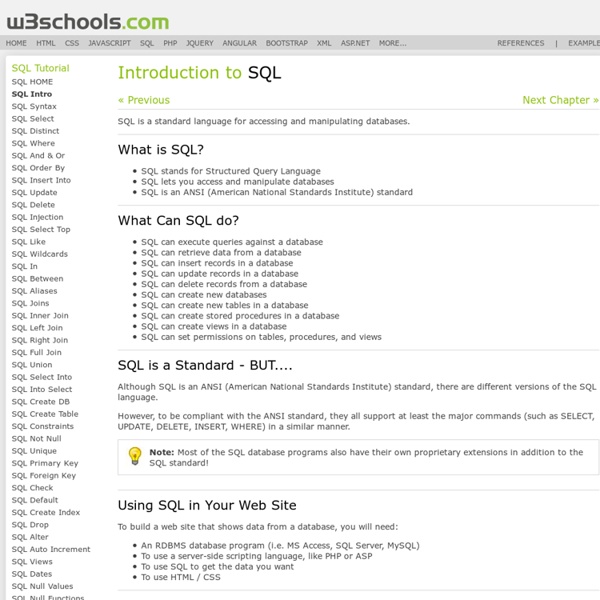



Windows Vista Torrent PostgreSQL advances to rank 4 in DB-Engines Ranking Blog > Post by Paul Andlinger, 4 March 2013 Despite losing a few score points since last month, PostgreSQL managed to move up one rank to become #4 in our ranking. It was only at rank #6 half a year ago. An impressive achievement in a short period of time. See complete ranking of 129 systems. PostgreSQL is the second most popular open source database management system, only behind MySQL. PostgreSQL has a very active and vocal, almost fanatical community. Share this page Find us on these platforms DB-Engines on
Learn SQL The Hard Way An Introduction To The Most Popular And Least Loved Data Language In The World Learn SQL The Hard Way Python | Ruby | C | Regex Learn SQL The Hard Way Table Of Contents Frequently Asked Questions How long does this course take? You should take as long as it takes to get through it, but focus on doing work every day. What kind of computer do I need? You will need either a Windows, OSX or Linux computer to complete this book. Copyright (C) 2010 Zed. Credits Introduction Welcome to Tizag.com's HTML Tutorial! Here you will learn the basics of HyperText Markup Language (HTML), so that you may design your own web pages like the one you are viewing right now! HTML is not a programming language, but rather a markup language. If you already know XML, HTML will be a snap for you to learn. If you are new to HTML and haven't read through our Beginner's Tutorial, please take a few minutes to complete that tutorial before moving on. Creating an HTML document is easy. HTML hasn't been around for many years. Here are some important facts about why web pages are so useful! They are a low-cost and easy way to spread information to a large audience. Throughout this tutorial, we will be using several terms that are unique to HTML. Tag - Used to tag or "mark-up" pieces of text. Report a Bug or Comment on This Lesson - Your input is what keeps Tizag improving with time!
PostgreSQL: The world's most advanced open source database SQL - Syntax SQL is followed by unique set of rules and guidelines called Syntax. This tutorial gives you a quick start with SQL by listing all the basic SQL Syntax: All the SQL statements start with any of the keywords like SELECT, INSERT, UPDATE, DELETE, ALTER, DROP, CREATE, USE, SHOW and all the statements end with a semicolon (;). Important point to be noted is that SQL is case insensitive, which means SELECT and select have same meaning in SQL statements, but MySQL makes difference in table names. So if you are working with MySQL, then you need to give table names as they exist in the database. SQL SELECT Statement: SELECT column1, column2....columnN FROM table_name; SQL DISTINCT Clause: SELECT DISTINCT column1, column2....columnN FROM table_name; SQL WHERE Clause: SELECT column1, column2....columnN FROM table_name WHERE CONDITION; SQL AND/OR Clause: SELECT column1, column2....columnN FROM table_name WHERE CONDITION-1 {AND|OR} CONDITION-2; SQL IN Clause: SQL BETWEEN Clause: SQL LIKE Clause: DESC table_name;
Seven Things Every Software Project Needs to Know About Ajax Pearltrees Asimov goes live Pearltrees can best be described as a visual and collaborative library that allows users to easily curate and keep track of their favorite subjects. Today, the PearlTrees introduced a major upgrade to the platform dubbed Asimov. "Essentially, Asimov is the foundation for Pearltrees’ transformation into a universal file manager for our post PC world," PearlTrees rep Oliver Starr told TG Daily. "This major redesign creates a universal experience across every platform - today on the Web, iPhone and iPad - very soon on Android and ultimately glasses, watches, tabletops, really anything you can imagine." According to Starr, the Asimov release is highlighted by a number of new features including: Pearltrees first launched as a Beta platform in December 2009 achieving a 1.0 release in November 2012.
SQLZOO Learn SQL using: SQL Server, Oracle, MySQL, DB2, and PostgreSQL. Reference: how to... How to read the data from a database. 2 CREATE and DROP How to create tables, indexes, views and other things. 3 INSERT and DELETE How to put records into a table, change them and how to take them out again. 4 DATE and TIME How to work with dates; adding, subtracting and formatting. 5 Functions How to use string functions, logical functions and mathematical functions. 6 Users How to create users, GRANT and DENY access, get at other peoples tables. 7 Meta Data How to find out what tables and columns exist. 8 SQL Hacks Some SQL Hacks, taken from "SQL Hacks" published by O'Reilly 9 Using SQL with PHP on Amazon EC2 servers Video tutorials showing how to run MySQL, PHP and Apache on Amazon's EC2 cloud servers. 10 An introduction to transactions Video tutorials showing how sessions can interfere with each other and how to stop it. 11 Using SQL with C# in Visual Studio